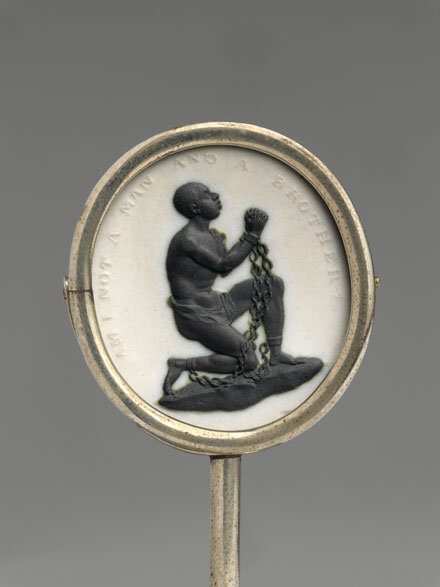This coming Saturday, September 26, Historic Deerfield will offer a one-day online forum, “The Bitter and the Sweet: The Material Culture of Sugar in Early New England.” Despite its popularity in the 17th and 18th centuries as a sweetener in beverages such as tea, coffee, hot chocolate, and punch, sugar in New England (and globally, for that matter) has a very bitter history. As the popularity of sugar increased, the amount of enslaved labor required to harvest sugar also increased to meet the ever higher demand. However, beginning in the 18th century in places such as England, critics of slavery and the slave trade grew louder, and took to expressing their condemnation of slavery on a variety of media, including ceramics. Josiah Wedgwood (1730-1795) was one such critic, producing in 1787 a ceramic medallion that effectively advocated the abolitionist cause (Fig. 1).

Designed by Henry Webber (1754-1826) and modeled by William Hackwood (1757-1839) for Josiah Wedgwood in 1787, the medallion incorporates a number of design and literary sources. Inspired by the seal for the Society for the Abolition of the Slave Trade in England, the medallion depicts an enslaved man kneeling in chains with clasped hands. The phrase, “Am I not a Man and a Brother?” appears above the man’s head, and is taken from a 1773 poem by Thomas Day (1748-1789) titled “The Dying Negro.” [1] The medallions were meant to be worn by both men and women, who incorporated them into bracelets and other jewelry, and used them to decorate snuff boxes.[2]
As a committee member for the Society for the Abolition of the Slave Trade, Wedgwood undoubtedly produced these medallions for members of the committee and like-minded supporters.[3] In fact, Wedgwood sent a large package to Benjamin Franklin (1706-1790), who at the time served as the President of the Philadelphia Society for the Abolition of Slavery. Franklin’s letter to Wedgwood shows just how effective the design of Wedgwood’s medallion was in gaining sympathizers:
Sir, I received the letter you did me the honor of writing on the 29th February past, with your valuable present of Cameos, which I am distributing among my friends; in whose countenances I have seen such marks of being affected by contemplating the figure of the Suppliant (which is admirably executed) that I am persuaded it may have an Effect equal to That of the best written Pamphlet in procuring Favour to these oppressed People.[4]
While there is no record of how many medallions Wedgwood manufactured, some estimate that the number may have exceeded 10,000.[5] Entrepreneurial Staffordshire potters eventually copied Wedgwood’s medallion in the 1790s, including T. & J. Hollins (ca. 1795-1820), but these firms chose to retail rather than distribute them freely as did Wedgwood.[6]
In addition to cameos, Wedgwood produced similar black basalt intaglio seals.[7] Used to seal letters with hot wax, the seal and its design would have clearly communicated the letter writer’s moral convictions to the recipient. Wedgwood manufactured other anti-slavery basalt intaglios, including one in the collection of the British Museum, depicting an enslaved male figure and the phrase “May industry be rewarded.”[8]
Register for “The Bitter and the Sweet: The Material Culture of Sugar in Early New England” by September 24 at https://www.historic-deerfield.org/events/2020/4/4/the-bitter-and-the-sweet-the-material-culture-of-sugar-in-early-new-england-2dt9p
[1] Elizabeth Bryding Adams, The Dwight and Lucille Beeson Wedgwood Collection at the Birmingham Museum of Art (Birmingham, Alabama: Birmingham Museum of Art, 1992), 106.
[2] Mary Guyatt, “The Wedgwood Slave Medallion: Values in Eighteenth-Century Design,” Journal of Design History 13, no. 2 (2000): 97.
[3] Ibid., 96-97.
[4] Quoted in Adams, The Dwight and Lucille Beeson Wedgwood Collection, 106.
[5] Guyatt, “The Wedgwood Slave Medallion,” 96.
[6] Ibid., 97.
[7] A mold for one intaglio seal, modeled by William Hackwood, can be found in the collections of the Wedgwood Museum (accession number: 1004).
[8] Accession number.: 1887,0307,I.556.